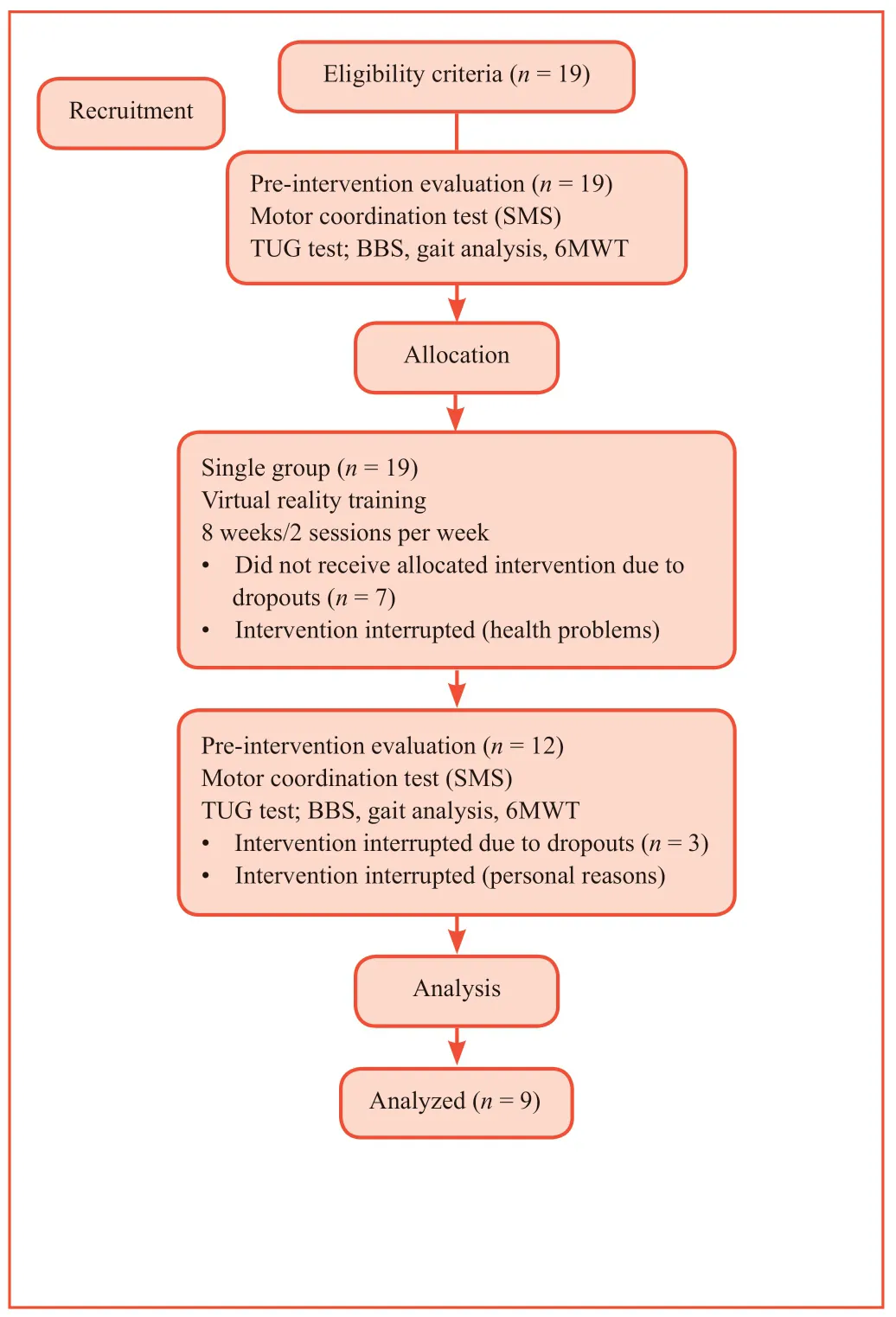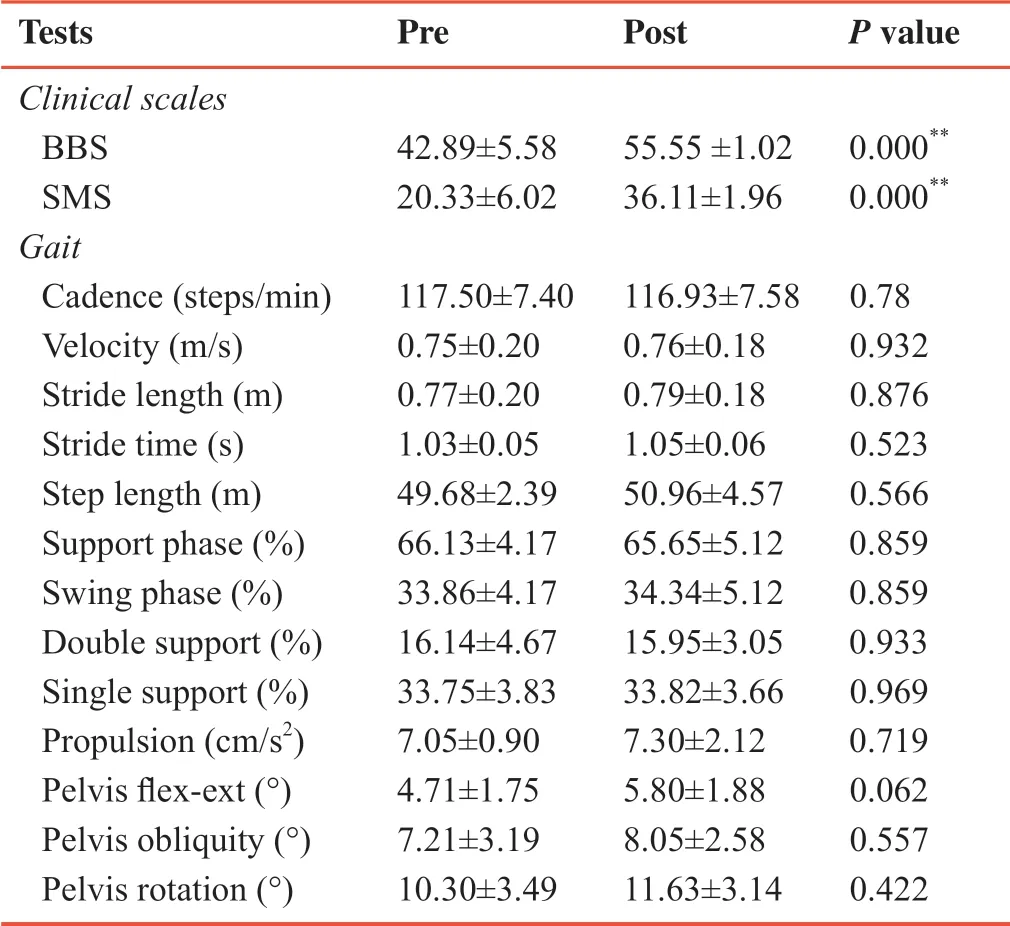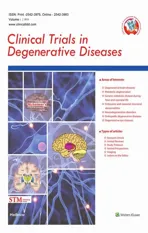Effects of exergames on motor coordination and balance in convalescent drug addicts:a feasibility study
2019-03-30AdrieleNunesSalesJaneTerezinhaFincklerBotelhoArislanderJonathanLopesDumontAnaFranciscaRozinKleinerGilenoEduLameiradeMelo
Adriele Nunes Sales,Jane Terezinha Finckler Botelho,Arislander Jonathan Lopes Dumont,Ana Francisca Rozin Kleiner ,Gileno Edu Lameira de Melo,
1 Department of Sports,University of State of Para,Campus de Altamira,Altamira,PA,Brazil
2 Doctoral and Master Program in Rehabilitation Sciences,Nove de Julho University,São Paulo,Brazil
3 Department of Physiotherapy,Neuropediatrics Section,Federal University of São Carlos,São Carlos,Brazil
Abstract
Key words:addicts;static balance;dynamic balance;motor coordination;virtual reality;rehabilitation;exergames;Xbox
INTRODUCTION
According to the United Nations Office on Drugs and Crime,1approximately 29.5 million individuals use illegal drugs and have disorders related to the consumption of these substances.Indeed,chemical dependency is currently one of the problems that most affect society.2Indiscriminate drug use can cause dependence.Also,it is related to memory lapses,poor attention,difficulty concentrating,incoherent speech,sleep disorders,weight loss,indifference with regard to personal hygiene and appearance,and harm to both motor coordination and balance.3,4
According to Souza et al.'s study,5the organization of cognitive functions and psychomotor self-control are impaired in addicts,since the prefrontal cortex is damaged by the daily use of drugs.As consequence,the addict has difficulties in performing some activities of daily living.Moreover,the neuromotor pathways are also impaired by excessive drug use,causing serious problems with regard to static and dynamic balance.
During the withdrawal phase in recovering addicts,the practice of aerobic activities promotes an increase in the metabolic demand.It results in the adaptation of the main neural pathways and offers benefits,such as the normalization of the levels of attention,memory and motor control.5Virtual reality is an option that enables achieving improvements in motor coordination and balance by the practice of body movements through pleasurable physical activities.6
Virtual reality is used to motivate individuals with motor disabilities to practice physical movements actively and repeatedly in a playful manner.7This tool has been used with increasing frequency in rehabilitation processes of several pathologies,especially for achieving improvements in postural control,gait and mobility.8-10
However,few studies have addressed treatment with virtual reality for improving balance and motor coordination in addicts.Therefore,the aim of the present study was to evaluate the influence of virtual reality in rehabilitation of motor coordination and balance in drug addicts recovering.Our hypothesis is that gait training with virtual reality is capable of improving balance and motor coordination in this population.
PARTICIPANTS AND METHODS
Study design
A prospective self-controlled study.
Study participants
Subjects were recruited from May to July 2017.Interventions and evaluations were carried out from August to October 2017.This study was conducted at the Rescuing Lives Center for Recovery from Alcohol and Drugs,Altamira,Brazil and received approval from the Human Research Ethics Committee of theUniversidade do Estado do Pará- XII Campus (certificate number:2.129.360) on April 7,2017 (Additional file 1) and in accordance with theDeclaration of Helsinki.All participants received clarifications regarding the procedures of the study and signed a statement of informed consent (Additional file 2).
Inclusion criteria
·Age 18 years or older
·Being an addict and resident at the Rescuing Lives Center for Recovery from Alcohol and Drugs
·Not currently using illegal drugs
Exclusion criteria
·Age less than 18 years
·Physical disability that impedes the execution of the protocols
·Severe neurological or psychiatric disorder
·Severe heart disease
·History of seizure
Virtual reality procedures
The addicts participated in sixteen 45-minute training sessions at a frequency of twice a week.Each participant stood two to three meters in front of the Kinect Xbox 360TMmotion sensor (Microsoft Corporation,Redmond,WA,USA) and a 40′ television reproduced the images of the following games:Just Dance2016,Kinect Adventures,Game Kinect SportsandGame Kinect Sports 2.
Outcome measures
Evaluations were performed before and after the completion of all 16 intervention sessions by two evaluators who did not participate in the intervention procedures.The following scales and tests were administered:
Berg Balance Scale
The Berg Balance Scale (BBS)11was used to evaluate functional balance.This scale is based on 14 items common to daily living and is used for patients in rehabilitation for the treatment of balance deficits,independently of age.Each item is scored on a five-point scale from 0 (unable to perform the task) to 4 (able to perform the task independently).The total is determined by the sum of the item scores and ranges from 0 (severely impaired balance) to 56 points (excellent balance).A score of less than 45 points is a predictor of recurrent falls.11
Senior Motor Scale
Motor coordination was assessed using the Senior Motor Scale (SMS) adapted and developed by Rosa (2009).12The SMS is a battery of tests used to evaluate general motor fitness in terms of global coordination,balance and agility.For each of these variables,a sequence of levels from two to 12 is proposed in the form of tests that gradually increase in difficulty.The score is calculated individually for each of the motor aspects by the sum of positive results on the tests.The scale is indicated for individuals at risk of motor impairment,those with a sedentary lifestyle and those with mental,psychological and neurological behavior disorders.
Assessment of mobility and gait
A portable,wireless,inertial sensor (G-WALK,Gsensor,BTS Bioengineering SpA,Garbagnate Milanese,Italy) was used for the evaluation of spatiotemporal gait parameters,Timed Up and Go (TUG) test and 6-minute walk test (6MWT).The device was attached to the participant's waist with a semi-elastic strap at the height of the L4-5 intervertebral space.G-WALK is composed of a 16-bit triaxial accelerometer with a multiple sensitivity axis (± 2,± 4,± 8 and ± 16 g),13-bit triaxial magnetometer (± 1200 μT) and 16-bit triaxial gyroscope with a multiple sensitivity axis (± 250,± 500,± 1000 and ± 2000 °/s).
TUG
TUG test13is used to evaluate mobility and consists of standing up from a chair without the aid of the arms,walking a distance of three meters with firm steps at one's habitual pace,turning around,returning to the chair and sitting down again.The test total time and subphases were measured by an inertial sensor.Performing the test in 10 seconds or less is indicative of normal mobility;11 to 20 seconds is within the normal limits for frail or disabled individuals and more than 20 seconds indicates that the individual needs assistance,further analysis and intervention.If the subject performs the TUG test in 14 seconds or more,it suggests that he/she is easy to falls.The following dependent variables were calculated:
a) Total time:time (in seconds) required to complete the TUG test;
b) The time (in seconds) for the following phases were computed:standing time;going phase;first rotation;back phase;and final rotation - sitting phase.
c) For the standing and sitting phases,the following trunk angles (in degrees) were computed:flexion peak;flexion range of motion;extension peak;and,extension range of motion.
6MWT
6MWT14was performed in a flat corridor on which 30 meters were marked at one-meter intervals.The width of the track was 1.5 meters and the participants performed the test without assistance following the guidelines of the American Thoracic Society (2005)14.The participant was instructed to walk as fast as possible for six minutes with standardized verbal encouragement at one-minute intervals.The inertial sensor was used to measure the distance traveled (in meters) during the test.
Physiological variables were determined before and after the 6MWT.Heart rate was measured using a pulse heart rate monitor (Polar®,model 90440,Kempele,Finland).Blood pressure was measured using a digital monitor (G-Tech BP3AF1-3,Onbo Electronic (Shenzhen) Co.,Ltd.,Shenzhen,China) with the participant in the sitting position.Perceived exertion was evaluated using the modified Borg scale15which ranges from 0 (no effort) to 10 (extreme effort).
Statistical analysis
Data are expressed as the mean ± SD.The IBM SPSS Statistics v.22 software (IBM,Armonk,NY,USA) was used for the statistical analysis.The data fulfilled the criteria of normality,as determined by the Kolmogorov-Smirnov test.The paired samplest-test was used for the comparisons,with the level of significance set to 5% (P<0.05).
RESULTS
Sample information
Nineteen individuals characterized as addicts initiated the evaluations and training sessions.Dropouts occurred over the course of the sessions due to the abandonment of treatment due to health reasons or personal problems.Thus,only nine individuals completed the training and were submitted to the second evaluation (Figure 1).Mean age was 25.78 ± 6.76 years;weight was 65.56 ± 9.88 kg;height was 1.69 ± 5.52 meters;and duration of drug use was 13.5 ± 5.78 years.The most consumed drugs prior to hospitalization were marijuana,cocaine,crack,cigarettes and alcohol.During their stay at the Rescuing Lives Center for Recovery from Alcohol and Drugs,the participants were not taking any drugs.

Figure 1:Study flow chart.
Clinical scales results
Significant improvements were found on the clinical scales:BBS (P<0.01) and SMS (P<0.01).Table 1 presents these results.

Table 1:Pre- and post-intervention clinical (BBS and SMS) and spatiotemporal gait parameters in recovering addicts submitted to virtual reality training at Rescuing Lives Center for Recovery from Alcohol and Drugs,Altamira,Brazil
Spatiotemporal gait parameters and TUG test results
No significant differences were found regarding the spatiotemporal gait variables (Table 1).However,for the TUG test,significant improvements post-intervention were found in the standing (flexion peak (P= 0.011);flexion range of motion (P= 0.007);extension peak (P= 0.013)) and sitting phases (extension peak (P= 0.018);extension range of motion (P= 0.003)).Table 2 displays the TUG test results.
6MWT and physiological variables results
The Table 3 displays the distance traveled on the 6MWT and physiological variables before and after the test.The minimum blood pressure (P= 0.031) improved after the intervention.No significant differences were found for the other variables analyzed.
DISCUSSION
The present study evaluated the influence of virtual reality training on motor coordination and balance in recovering addicts.According to Rocha et al.(2012),16virtual reality is a promising rehabilitation modality with the aim of enhancing motor performance,learning motor strategies and relearning motor skills lost due the harm caused by drug use.
Improvements in static and dynamic balance were found,as demonstrated by the results of the BBS.This finding is in agreement with data previously described,17-19which also showed remarkable improvements in balance following the use of virtual reality in population with movement disorders.Enhancements in motor coordination after virtual reality training were also found,as demonstrated by the results of the SMS.This finding is consistent with the data described by Araújo et al.20and Pavão et al.,21who reported significant improvements in the Motor Development Scale in patients with motor coordination deficit submitted to virtual reality training.
In the present study,an inertial sensor was employed to quantify the TUG and the 6MWT.Unlike the conventional TUG test,in which only the total time required to complete the task is recorded,the inertial sensor can determine the total time as well as the time required for the different components of the test (standing up,walking three meters,turning 180°,returning to the chair and sitting down again) as well as acceleration data,which are important data that reveal the quality of movement and specific mobility problems.This is known as the instrumented TUG test.22-25The data revealed noticeable improvements during the standing and sitting phases of the test,demonstrating the benefits of virtual reality training with regard to these aspects.According to previous results,26virtual reality increases dopamine in the brain.Therefore,the authors state that such training leads to significant improvements in mobility and balance.
Although no difference was found on the 6MWT,the participants walked a longer distance after the intervention (mean:362 meters prior to training and 419 meters after training).A previous study27involving virtual reality training found the difference in the distance travelled on the 6MWT,demonstrating an increase in functional independence.Previous studies28,29have demonstrated that the practice of physical activity leads to improvements in both balance and motor coordination,diminishing the possibility of falls.
When the physiological variables were analyzed,differences were found with regard to minimum blood pressure.The participants had a minimum blood pressure below normal limits prior to the intervention,which had increased to the normal range following the virtual reality training sessions.Nogueira et al.30report similar results and confirm the benefit of systematized physical activity administered by physical educators on the maintenance of blood pressure.
The present study has limitation that should be addressed.The lack of a control group limits the comparisons of the findings.Moreover,the dropouts that occurred during the training sessions due to personal reasons and health problems diminish the statistical power of the findings.

Table 2:Pre- and post-intervention Timed Up and Go test results among recovering addicts submitted to virtual reality training at Rescuing Lives Center for Recovery from Alcohol and Drugs,Altamira,Brazil

Table 3:Pre- and post-intervention distance traveled on six-minute walk test and physiological variables before and after test among recovering addicts submitted to virtual reality training at Rescuing Lives Center for Recovery from Alcohol and Drugs,Altamira,Brazil
Conclusions
In the present study,virtual reality training performed with the Xbox 360 Kinect system resulted in improvements in recovering motor coordination and balance in drug addicts,as demonstrated by results of the BBS,SMS and instrumented (inertial sensor) TUG test.
Additional files
Additional file 1:Ethical Approval Documentation.
Additional file 2:Model consent form.
Additional file 3:Data sharing.
Author contributions
Conception of the study:ANS and JTFB;data acquisition,analysis and interpretation,and the drafting of the manuscript:AJLD and AFRK;study design and performance:GELM.All authors approved the final version of the paper.
Conflicts of interest
None declared.
Institutional review board statement
The study had been approved by the Ethics Committee ofUniversidade do Estado do Pará- XII Campus (certificate number:2.129.360) on April 7,2017.The study was performed in strict accordance with theDeclaration of Helsinki.
Declaration of participant consent
The authors certify that they have obtained all appropriate participant consent forms.In the forms,participants have given their consent for their images and other clinical information to be reported in the journal.The participants understand that their names and initials will not be published and due efforts will be made to conceal their identity,but anonymity could not be guaranteed.
Biostatistics statement
The biostatisticians of the University of State of Para reviewed the statistical methods of this study.
Data sharing statement
Individual participant data that underlie the results reported in this article,after de identification (text,and tables),will be available upon request.Data will be available immediately following publication,no end date;for anyone who wishes to access the data.In order to gain access,data requestors will need to sign a data access agreement.Proposals should be directed to anafrkleiner@gmail.com.
Plagiarism check
Checked twice by iThenticate.
Peer review
Externally peer reviewed.
Open access statement
This is an open access journal,and articles are distributed under the terms of the Creative Commons Attribution-NonCommercial-ShareAlike 4.0 License,which allows others to remix,tweak,and build upon the work non-commercially,as long as appropriate credit is given and the new creations are licensed under the identical terms.
杂志排行
Clinical Trials in Degenerative Diseases的其它文章
- Effects of flash glucose-sensing technology-based continuous glucose monitoring on compliance of patients with type 2 diabetes mellitus:study protocol for a randomized controlled trial
- Effect of beraprost sodium on pulmonary hypertension due to left ventricular systolic dysfunction:protocol for a randomized controlled clinical trial
- Efficacy and safety of Mamajjaka Ghanavati in the treatment of type 2 diabetes mellitus:a prospective open label multi-center clinical study
- Information for Authors - Clinical Trials in Orthopedic Disorders
